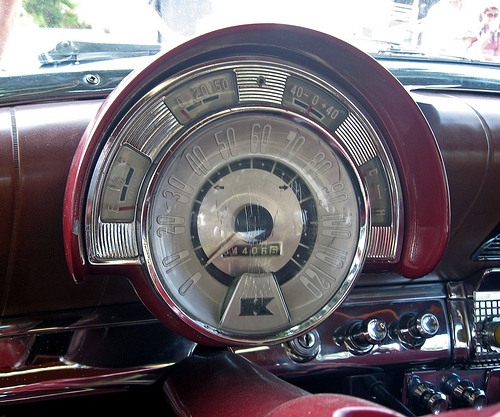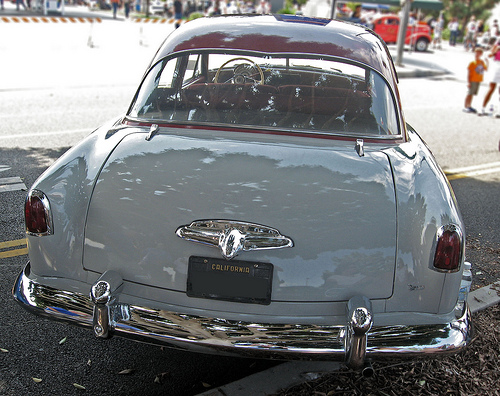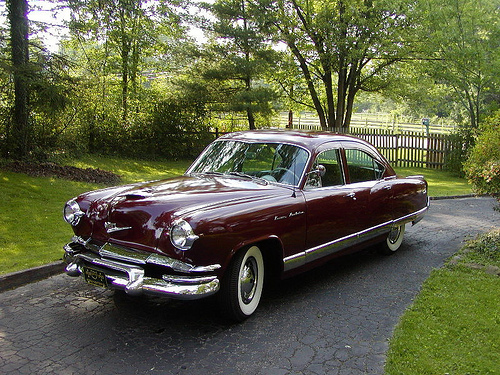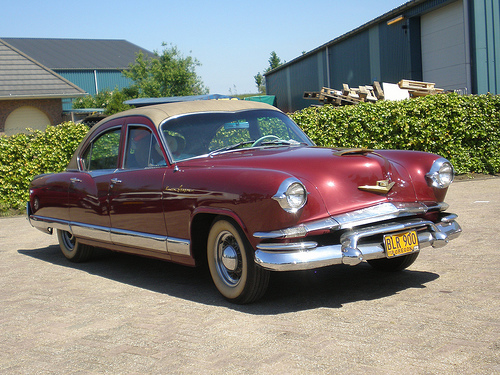KAISER’S LAST SPRING
Although the outbreak of hostilities in Korea curtailed buyer enthusiasm, Kaiser-Frazer sales for 1951 reached 231,608, beating 1948’s peak by 65%. Most of those sales were the new Kaiser, plus 81,942 Henry Js and 10,214 Frazers. (The latter were actually facelifted leftover 1950 models, the last gasp of the Frazer marque.)

The 1951 Kaiser’s fancy-looking (if somewhat illegible) instrument panel clusters all the secondary gauges around the speedometer. The previous generation’s dash had the gauges laid out horizontally on either side of the speedo. This is somewhat less elaborate than the snazzy two-tier dash originally planned for this car, which was canceled for cost reasons. Note the chrome trim on the dash; this is a Deluxe model, which has more interior brightwork than the basic Special. The speedometer’s 120-mph (193-km/h) upper limit, incidentally, is greatly optimistic. Actual top speed was perhaps 85 mph (136 km/h).
In addition to reinvigorated auto sales, Kaiser-Frazer also had new defense contracts, beginning with an $82 million agreement to build the Fairchild C-119 Flying Boxcar for the United States Air Force. The company subsequently signed a separate agreement to build the Lockheed P2V Neptune for the Navy. The contracts were far from lucrative considering the tooling expenses and retraining expenses involved, but Kaiser-Frazer needed the revenue and the contract enabled the company to utilize more of its considerable factory capacity. In fact, Edgar Kaiser had to reassure stakeholders that the aircraft contracts would not lead Kaiser-Frazer to abandon the automobile business.
Alarmingly, despite all the good news, Kaiser-Frazer still lost money for 1951: $12.3 million, almost as much as in 1950. Some of the loss reflected the money Kaiser-Frazer had spent to buy the Continental Motor Company’s Detroit Manufacturing Division, which made Kaiser’s engines. Nevertheless, the numbers were discouraging.
A central problem was that Kaiser-Frazer was still building more cars than it could sell. When sales slumped later in the year, the company ended up with 8,000 leftover ’51 cars. Kaiser-Frazer’s remaining Detroit veterans were also very critical of the company’s spending, chiding extravagances like allowing executives to order costly custom-trimmed cars for personal use. The fact that the Kaisers and many of their senior staff were still based in California also resulted in enormous travel costs.

The 1951 Kaiser’s suspension layout was very conventional — double wishbones in front, semi-elliptical leaf springs in back — but well-considered spring rates and lots of wheel travel gave it an exceptionally good ride. The tiny badge just below and inboard of the right taillight, barely visible here, says “Darrin styled.” Early 1947 Frazers bore a similar badge until Howard Darrin protested.
Perhaps the biggest and more difficult problem was the one that had led to the final split between Henry Kaiser and Joseph Frazer back in 1949: the company’s heavy reliance on credit to make up for its lack of capital. By 1951, Kaiser-Frazer’s already high overhead was further inflated by interest and finance charges on a debt load that now exceeded the aggregate market value of the company’s stock.

In 1951, the big Kaisers were offered in basic Special and plusher Deluxe trim. In 1952, the Special was renamed Deluxe and the previous Deluxe became the Kaiser Manhattan. A mild facelift stretched the the ’52s to 211.1 inches (5,363 mm) overall; the ’53s, like this one, got another minor touch-up, but their dimensions were unchanged. (Photo: “1953 Kaiser Manhattan” © 2008 Jim Lape; used with permission)
THE VALLEY OF THE SHADOW
The Korean War was a bitter time for the independent automakers. Although industry pressure discouraged the government from halting civilian production as it had done during World War II, Washington did impose caps on automobile production based on each automaker’s 1950 levels. Raw materials, which had been an issue for all automakers since 1945, again became scarce and anti-inflationary consumer credit restrictions were tightened. The uncertainty surrounding the grim police action also dampened the public’s interest in new car purchases.

The 1953 Kaisers were a little longer than the 1951s, now 211.3 inches (5,367 mm) overall, although the body was fundamentally the same. This is a 1953 Golden Dragon, a special trim package originally introduced early in the 1951 model year. It was revived in 1953 as a limited edition, sporting a unique interior of Laguna cloth and “Bambu” vinyl, styled by Carleton Spencer and fashion consultant Marie Nichols. (Photo: “Kaiser Golden Dragon 1953” © 2009 TedXopl2009; used with permission)
Kaiser’s first inauspicious 1952 offerings were 6,561 leftover 1951s re-serialized as 1952 Kaiser Virginians. Concurrently, 7,017 unsold 1951 Henry Js were fitted with optional Continental spare tires and sold as Vagabonds. The real 1952 Kaisers, mildly facelifted and sporting many minor improvements, did not appear until February 1952.
The true 1952 Kaisers had new names: Henry Js were now called “Henry J Corsair”; the previous Kaiser Special was renamed Deluxe; and the ’51 Deluxe was replaced by the 1952 Manhattan, a name Kaiser-Frazer had previously used for the top-of-the-line Frazers. Prices were also new and substantially higher than before, in some cases by more than $500.
The higher prices and rapidly shrinking demand for the Henry J slashed total 1952 sales to a dismal 57,265, including Virginians and Vagabonds. The military work held losses to “only” $4.7 million, but Kaiser-Frazer employees were already wondering if the company’s days were numbered.
One of the few bright spots during this period was the Kaiser-Frazer Export Corporation, started in early 1948 by Joseph Frazer’s nephew, Hickman Price, Jr., K-F’s former treasurer. The strength of the dollar had allowed the export subsidiary to establish assembly plants in Bombay, Haifa, Mexico City, and Rotterdam and made the export business consistently profitable despite Kaiser-Frazer’s reluctance to provide export-specific modifications and equipment. However, Price had grown frustrated and jumped ship in September 1952 to become president of Willys do Brazil, Willys-Overland’s Brazilian subsidiary.

What is most fascinating to me about Kaiser is how — from beginning to end — the fledgling automaker vastly overreached.
For starters, it was pure folly for the company to attempt to launch two new brands.
More significantly, replacing the first-generation body after only four years with a completely new design was a risky move for a newbie with little capital and a serious cost disadvantage. It didn’t help that the “Constellation” was half-baked. The low cowl and lack of a step-down chassis resulted in little trunk space and a weirdly tall greenhouse that arguably aged more quickly than a more traditional look.
Perhaps the biggest mistake Kaiser made was to launch a compact with little parts interchangeability with its family cars. The company could only afford one platform.
The original Kaiser body was modern enough for a six-year run. However, it desperately needed a shorter, lighter, entry-level variant better matched to the Continental six.
Ironically, Kaiser’s best hope for survival may well have been a penny-pinching effort to perfect the “small” stuff that made for a better ownership experience. During the early-50s innovative ideas tended to backfire on all of independents, e.g., Studebaker’s rust-bucket Loewy coupes, Nash’s ugly airflyte styling and Packard’s trouble-plagued 1955s.
[quote]However, it desperately needed a shorter, lighter, entry-level variant better matched to the Continental six. [/quote]
I think they really just needed a better engine. K-F’s earlier attempt at a stripped-down model was still more expensive than some direct rivals, probably a reflection of the company’s production overhead. A cheaper, short-wheelbase car would likely have cost almost as much to build, but would have been perceived as downmarket, so people would have expected a lower price that K-F could have provided only by cutting their margins even thinner. A conundrum.
The Henry J was a miscalculation in a number of ways, its lack of commonality with the big cars being only one of them. That design was based on a proposal from American Metal Products, which had been pitched to Henry Kaiser in 1948, around the time he was negotiating with the RFC for additional loans. Kaiser accepted it (although the original proposal had to be extensively and expensively redesigned), because it seemed an expedient way to fulfill the promise he’d made to the feds that he’d build a cheap people’s car. Some of the Frazer people thought it was a really bad idea, but Henry dug in his heels; at least one board member resigned over it.
Dutch Darrin told Dick Langworth that he had proposed a compact based on the ’51 full-size car, on a 105-inch wheelbase and sharing a lot of the same tooling. Darrin thought that on balance, it would have been cheaper to build, but the Kaiser engineers rejected it. Darrin thought it was because they didn’t want to have to pay him a royalty on it, although since the Kaisers and most of their people declined to talk to Langworth about it, I don’t know if that was the actual rationale or not.
The most plausible justification for the Constellation was that it could be a better basis for a compact than the first-generation Kaiser. So too bad Darrin’s proposal didn’t prevail.
Kaiser could have had a more viable compact entry than Willys and Hudson if it had managed to keep the price down. Was that much more possible with a Constellation body than the original Kaiser?
Despite the short, 105-inch wheelbase, a Constellation-based compact would have been heavier and wider than the Aero, Jet or first-generation Rambler. Perhaps the best comparison would have been with the 1956 Rambler, which pulled enough parts from the senior Nash’s to be more of a mid-sized car despite its compact dimensions.
However, unlike the tall-and-boxy 1956 Rambler, roominess would not have been the greatest strength of a compact Constellation. Much like the 1953 Studebakers, the Kaiser’s low cowl was best used on a two-door hardtop. Put on a 105-inch wheelbase, a Kaiser hardtop could have been an interesting cross between a Studebaker Starliner and a Rambler Country Club hardtop (which was Rambler’s best-selling model in both 1952 and 1953).
[quote]Was that much more possible with a Constellation body than the original Kaiser? [/quote]
Well, according to Darrin, the argument went that the AMP prototype would be cheaper to build in terms of parts and materials cost per unit, but the Constellation-based car would have involved far less investment in tooling (and engineering, since the AMP car ended up having to be substantially redesigned for production). So, Darrin’s proposal probably would have made it easier for K-F to break even. I don’t think the Kaisers were thinking in those terms, though; they assumed the compact was going to be a big seller, which would have allowed them to pay off the tooling costs fairly quickly.
Fundamentally, I think K-F (and Willys and Hudson) just overestimated the actual demand for smaller cars. A lot of buyers [i]said[/i] they wanted a compact, but (as I said in the Jet article), prior to the Eisenhower recession, I think a lot of that was reaction to postwar sticker shock, and the presumption that smaller car=cheaper car. I don’t think K-F could have sold a Constellation-based car for much cheaper than they did the Henry J, and I don’t think they grasped the point George Mason and Romney recognized about market positioning.
So, I don’t think a Constellation-based car would have sold vastly better, but it might have been easier for them to make money on the volume they did sell, or at least lose less.
[quote=Administrator]On his own initiative, he decided to set up tooling in the Rotterdam plant for a new rear panel with an opening trunk lid. He didn’t ask for permission from the home office, since he assumed they would say no. Of course, the Kaisers found out about it soon enough anyway, and decided it was a good idea — hence the Accessory Group. [/quote]
It’s easier to get forgiveness than permission!
I think the early Henry J’s lacked an opening trunk lid because as a condition of receiving RFC aid, the price of the car could be no more than $1300.
There’s an interesting (at least to me!) historical parallel here. When the Saab 92 (Saab’s first car) was in development, Saab heard that the then-upcoming Volvo 444 was going to sell for 4400 Swedish kronor, which I think was equivalent to US$880. At that point, Saab’s cost to build the 92 was projected to be more than SKr4400, so away went the trunk lid. The Volvo 444’s price didn’t turn out that low after all, and at some point in the next few years, the 92 got an opening trunk lid.
In his autobiography, [i]The Real Frank Zappa Book[/i], rock musician Frank Zappa mentioned his family’s move (in a Henry J) from Baltimore to the Los Angeles area in the early 1950s. His take on the back seat was, "I spent two weeks on this ironing board from Hell."
The lack of a decklid and glove compartment were definitely part of an effort to meet the RFC price target — Henry Kaiser had promised the feds that the K-F compact would have an MSRP under $1,200. Even with those economy measures, the Henry J still missed that mark by around $25, although I assume the RFC decided it was close enough. (Incidentally, Hickman Price told Dick Langworth that a fair number of the cost-cutting tricks were suggested by Kaiser himself.)
According to Price, the way the Henry J eventually got its decklid was rather convoluted. At the time the Henry J debuted, Price was the head of Kaiser-Frazer Export. A couple of years earlier, he had set up a factory in Rotterdam to supply cars to other export markets (apparently, the exchange rate of the guilder to other currencies was less onerous than with the dollar). When the Henry J came out, Price thought it had obvious export potential — it was the right size — but the lack of a decklid was a big obstacle. On his own initiative, he decided to set up tooling in the Rotterdam plant for a new rear panel with an opening trunk lid. He didn’t ask for permission from the home office, since he assumed they would say no. Of course, the Kaisers found out about it soon enough anyway, and decided it was a good idea — hence the Accessory Group.
Price thought the Henry J could have sold much better overseas than it did, but he said that Kaiser-Frazer was very reluctant to spend the money on export-specific modifications, like heavy-duty suspension. Some of those the Export company ended up doing itself, but there was never a factory right-hand-drive version, for instance, which limited business in markets like the UK and Japan.
(I should note that I’m not sure how unbiased Price’s perspective may have been — he was Joe Frazer’s nephew, and by 1950, Frazer was effectively out, although he remained on the payroll for a while longer.)
As for the Henry J’s rear seat, the standard upholstery was basically plastic-coated paper, so I imagine that a cross-country drive in mid-summer would have become rather miserable in a hurry.
Hello Aaron. Nice post! But I have to clarify that Juan Peron neither was a dictator, nor leaded a regime in Argentina. He was a president elected by popular vote (over 50%) three times, in 1946, 1952 and 1973.
Luciano
A fair point. Duly amended.
Thank you very much, Aaron. Your history articles are much appreciated.
Where can one find images of Dutch Darrin’s original design proposal of Kaiser’s small car that resembled a downscaled version of the 1951 full-size Kaiser?
A pity Kaiser-Frazer never gave the green light to the 288ci Kaiser V8, wonder how it would have fared had the experimental V8 reached production.
I don’t remember if there were images of Darrin’s proposal in Richard Langworth’s book on Kaiser-Frazer — it’s been years since I looked at that book — but if any images survived to that point, I imagine he would have included them.
Aaron, thanks for a typically excellent set of observations woven into a pair of good stories re: the Kaiser-Frazer. Coupling the Kaiser-Frazer story with those of Hudson, Nash, Packard, and Studebaker, it seems to me that the “independents” were probably doomed to failure under the onslaught of the Big Three, even when one accounts for the bad management and business decisions. The only one of these decisions that appears to have been valid was Romney’s small car niche market play. How that would have worked out, had it been continued after his departure, is a good question, however, as a small company would have lacked the resources to develop the technology for more efficient and cleaner engines by the 70s.
It’s in this matter that I would like to add a personal comment: I can’t judge Kaiser-Frazer and cite personal experience regarding the automobile, but I do feel qualified to offer up some valid observations on the 226 Continental engine that Kaiser used. My view is that you have been far too generous in your assessment of this engine.
As a youngster, I worked in a shop rebuilding engines for lift trucks, which Continentals largely powered in brands such as Towmotor and Clark. and the large 6000# capacity trucks used the same 226 6. They are undoubtedly the cheapest things I’ve ever worked on, and their durability compared poorly with the more expensive Chrysler Industrial sixes. My understanding was that, even though they were used in other automotive uses, they were primarily an industrial engine for use on welders, generators, and water pumps — applications where a steady speed was all that was necessary and where the braking forces of an automobile were not constantly introduced — one of the things that limited this engine’s durability in Kaisers.
Using such tired iron could not be the way to succeed. I wonder how, after reading your article, a Kaiser would have faired with a Rocket Olds V8. Undoubtedly there would be more power, but the Rocket V8 would place several hundred pounds of iron squarely over the front wheels. I can’t imagine this doing much good for the car’s road manners.
I have wondered why Kaiser went to GM, rather than Hudson or Nash? Hudson had a good flathead six that, while larger than the lump of Continental iron, put out just as much power as the vaunted Olds V8 and thrashed it at the track, to boot. Granted, it would have been a heavier power plant than the Continental, as well.
Perhaps a better choice would have been the Nash 6, which was a very capable OHV design and proved its abilities in the British Healeys. One of these would have been much more durable than the Continental and lighter than a Rocket V8, and given Nash’s situation, perhaps available at a more reasonable price. Running a McCulloch supercharger on one of these engines would have been a more reasonable proposition, as well.
But as I said, I doubt that Kaiser-Frazer was going to work out in the long run, no matter what course of action was taken.
Even if Hudson or Nash had been willing to sell engines to Kaiser-Frazer, I don’t think trading a six for a six would have done Kaiser any good from a marketing perspective, at least in the price league in which they were trying to compete. That was certainly Hudson’s experience, racing legacy notwithstanding. As for the big Nash six, it should be remembered that the Healeys had to do quite a big of work on it to make a competition engine, and its performance in the Nash-Healey was also a reflection of that car’s being a bunch lighter than a Nash sedan or even the lighter Kaiser sedans.
The other consideration, and I assume one of the reasons Edgar Kaiser went to Oldsmobile, is which other manufacturers would have had the production capacity (and the willingness) to supply engines to an outside company. That might have been a touchier issue with another independent, even if there had been other advantages to such a deal.
my dad had a1952 Kaiser Frazer 4door with push button doors
Very interesting reading about Kaiser in our post-Tesla world – they certainly did a much better job differentiating their products from the mainstream car companies than Kaiser/Fraser did.